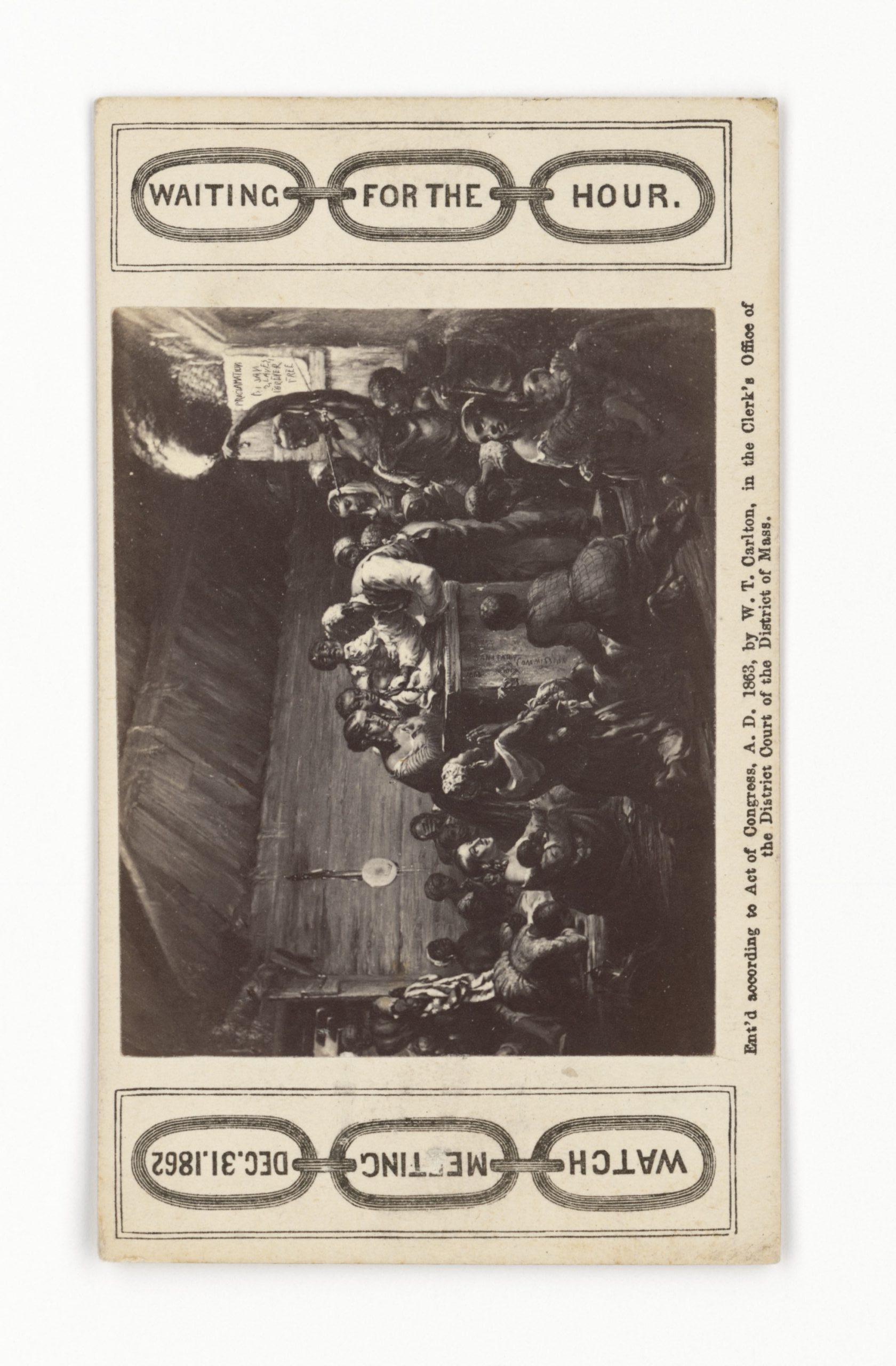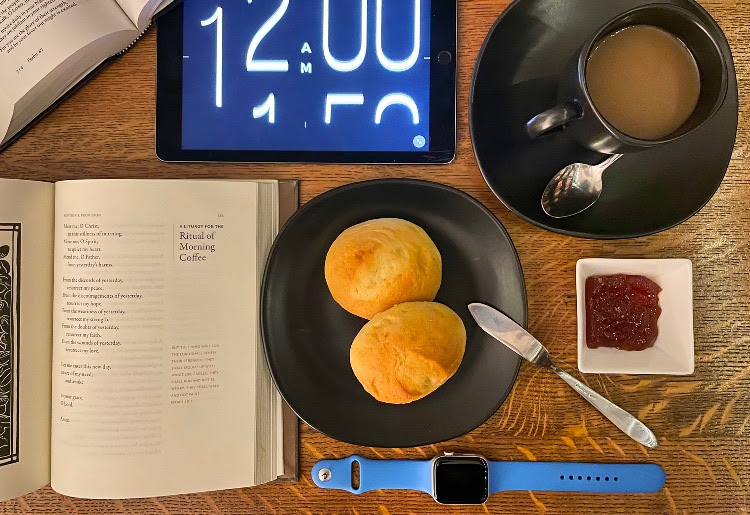
ABOUT THE ART
Heard & Moseley, American. Subject of William Tolman Carlton, American, 1818 – 1888. Waiting for the Hour – Watch Meeting Dec 31, 1862. 1863. Albumen and silver nitrate on photographic paper. 4 1/4 x 2 1/2 in. (10.8 x 6.4 cm). Washington, D.C. Collection of the Smithsonian National Museum of African American History and Culture.
Watch Night – December 31st
Believe it or not, January 1st is not a major ancient Christian holiday. It is the Feast of the Circumcision of Our Lord, also called the Feast of the Holy Name, but it has not always functioned as a new beginning. Up until the Middle Ages, there were various new year days celebrated in the Christian world—September 1st, Christmas, Easter, March 1st, or April 1st (Fool’s Day). It took until the 1582 reforms of the Gregorian calendar to set the start of the new year to January 1. This day is mostly a cultural festival with late-night parties on December 31st and “lucky” meals on the first day of the year. Black-eyed peas (or other peas) represent coins, and greens represent dollars. Ham is a symbol of wealth.
The Moravian tradition, however, offers a special custom called the Watch-night Service. This has been widely adopted by Methodists and other Protestant groups. At a Watch-night Service, one repents of their sins and seeks to start the new year with a clean slate. In Methodism, in particular, there is a recommitment to Christ for a new year with the Wesleyan Covenant prayer. Included in many of these services is a “love feast.” A love feast has a common heritage to Holy Communion in the Bible but ended up as a separate meal. Because it is not an official sacrament, it can be celebrated without a pastor or priest, and among people of different traditions. A love feast service usually consists of testimony or witnessing and song. This is all celebrated with a special sweet love feast bun and a cup of sweetened coffee. It is a meal of celebration and communion with the gathered people. In fact, it embodies many of the elements that Holy Communion is meant to have, but the church has lost over the years.
One way to bring this tradition to your home is to have your family share their favorite parts of the ending year, then go around a second time with one thing they are looking forward to in the new year. This may end with a covenant prayer by John Wesley taken from the Puritan tradition:
“I am no longer my own, but thine.
Put me to what thou wilt, rank me with whom thou wilt.
Put me to doing, put me to suffering.
Let me be employed by thee or laid aside for thee,
exalted for thee or brought low for thee.
Let me be full, let me be empty.
Let me have all things, let me have nothing.
I freely and heartily yield all things
to thy pleasure and disposal.
And now, O glorious and blessed God,
Father, Son, and Holy Spirit,
thou art mine, and I am thine. So be it.
And the covenant which I have made on earth,
let it be ratified in heaven. Amen.”

Moravian Love Feast Bun
This recipe is adapted from a recipe from Winkler Bakery in Old Salem, North Carolina. Winkler Bakery is a Moravian bakery opened in 1800 and still open today! Enjoy the buns with your favorite sweetened coffee.
Keep the screen of your device on
Ingredients
1 cup 1 hot mashed potatoes, unseasoned
1/2 cup 1/2 cup milk, room temperature
1 cup 1 granulated sugar
8 tablespoons 8 butter, room temperature
2 2 eggs, beaten
5 1/4 cups 5 1/4 (1 1?2 pounds) flour
1/4 teaspoon 1/4 nutmeg
4 1/2 teaspoons 4 1/2 (2 packages) Active Dry Yeast
1/2 cup 1/2 warm water
2 tablespoons 2 grated orange rind
2 tablespoons 2 grated lemon rind
2 tablespoons 2 orange juice
1 tablespoon 1 lemon juice
Directions
- Medium dice 1 large or 2 medium russet potatoes then place in boiling water for 10 – 12 minutes or until tender when pierced with a fork. Drain water and return to heat for a minute or two, evaporating off extra water from the pan. Mash the potatoes and separate 1 cup of hot mashed potatoes.
- Cream 8 tablespoons butter and 1 cup sugar; add the 1 cup of mashed potatoes and mix well. Add 1/2 cup of room temperature milk and 2 eggs. Mix well.
- Dissolve 4 1/2 teaspoons of Active Dry Yeast in 1/2 cup of warm water by gently stirring with your finger and then let sit for 5 minutes. After five minutes, add to mixture.
- Add the 1?4 teaspoon nutmeg, 2 tablespoons grated orange rinds, 2 tablespoons grated lemon rind, 2 tablespoons orange juice and 1 tablespoon lemon juice.
- Add around 1 1/2 lbs of flour and combine until a soft dough forms.
- Knead dough on a well-floured surface for 5 – 10 minutes. Form the dough into a ball and then place in a lightly greased bowl. Cover with a cloth and let rise in a warm place for 1 1/2 to 2 hours or until about doubled in size.
- Punch the dough down and then let the dough rise again for five to ten minutes.
- Flouring hands well (dough will be sticky) form the dough in to small balls of about three ounces.
- Place the small rolls on a cookie sheet. Slash tops with a knife to release air. Cover and let rise for another 1 1/2 hours or until doubled in size.
- Bake at 350°F degrees, or until golden brown, about 20 minutes.